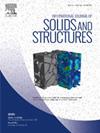Isolating the effects of deviatoric and hydrostatic stress on damage evolution using cold extrusion experiments
IF 3.4
3区 工程技术
Q1 MECHANICS
International Journal of Solids and Structures
Pub Date : 2024-12-25
DOI:10.1016/j.ijsolstr.2024.113205
引用次数: 0
Abstract
Ductile damage evolution is known to be dependent on stress triaxiality and Lode parameter. An experimental isolation of these two influencing factors is challenging, especially at large plastic strains, since a variation of the Lode parameter is usually accompanied by a variation in the triaxiality. In this study, forward rod extrusion and forward hollow extrusion are utilized to induce Lode parameters (L) of −1 and 0, respectively, while keeping the triaxiality and the plastic equivalent strain the same in both processes. For the triaxiality this is accomplished by superposing hydrostatic pressure by a counterpunch during forward rod extrusion. This allows for the first time, to the author’s knowledge, to experimentally study the isolated effect of the Lode parameter on void evolution at large plastic strains, and the resulting effects on product performance like impact toughness. Mass density measurements and scanning electron microscopy (SEM) on extruded samples of the case hardening steel 16MnCrS5 reveal an increased damage evolution under L = 0 as compared to L = −1. The SEM investigations show a distinct switch in void nucleation mechanisms from cracking of manganese sulphide inclusions for L = −1 to cracking and debonding of inclusions and surrounding matrix for L = 0. The debonding occurs in a preferred direction, leading to anisotropic void area fractions. The locations of inclusion-matrix-debonding are verified by evaluation of interface stresses between matrix and inclusion in representative volume element simulations. While the impact toughness of specimens extracted along different orientations is consistently different, this cannot be conclusively attributed only to the corresponding microscopic damage anisotropy.
求助全文
约1分钟内获得全文
求助全文
来源期刊
CiteScore
6.70
自引率
8.30%
发文量
405
审稿时长
70 days
期刊介绍:
The International Journal of Solids and Structures has as its objective the publication and dissemination of original research in Mechanics of Solids and Structures as a field of Applied Science and Engineering. It fosters thus the exchange of ideas among workers in different parts of the world and also among workers who emphasize different aspects of the foundations and applications of the field.
Standing as it does at the cross-roads of Materials Science, Life Sciences, Mathematics, Physics and Engineering Design, the Mechanics of Solids and Structures is experiencing considerable growth as a result of recent technological advances. The Journal, by providing an international medium of communication, is encouraging this growth and is encompassing all aspects of the field from the more classical problems of structural analysis to mechanics of solids continually interacting with other media and including fracture, flow, wave propagation, heat transfer, thermal effects in solids, optimum design methods, model analysis, structural topology and numerical techniques. Interest extends to both inorganic and organic solids and structures.

 求助内容:
求助内容: 应助结果提醒方式:
应助结果提醒方式:


